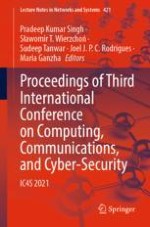This book features selected research papers presented at the Third International Conference on Computing, Communications, and Cyber-Security (IC4S 2021), organized in Krishna Engineering College (KEC), Ghaziabad, India, along with Academic Associates; Southern Federal University, Russia; IAC Educational, India; and ITS Mohan Nagar, Ghaziabad, India, during October 30–31, 2021. It includes innovative work from researchers, leading innovators, and professionals in the area of communication and network technologies, advanced computing technologies, data analytics and intelligent learning, the latest electrical and electronics trends, and security and privacy issues.
